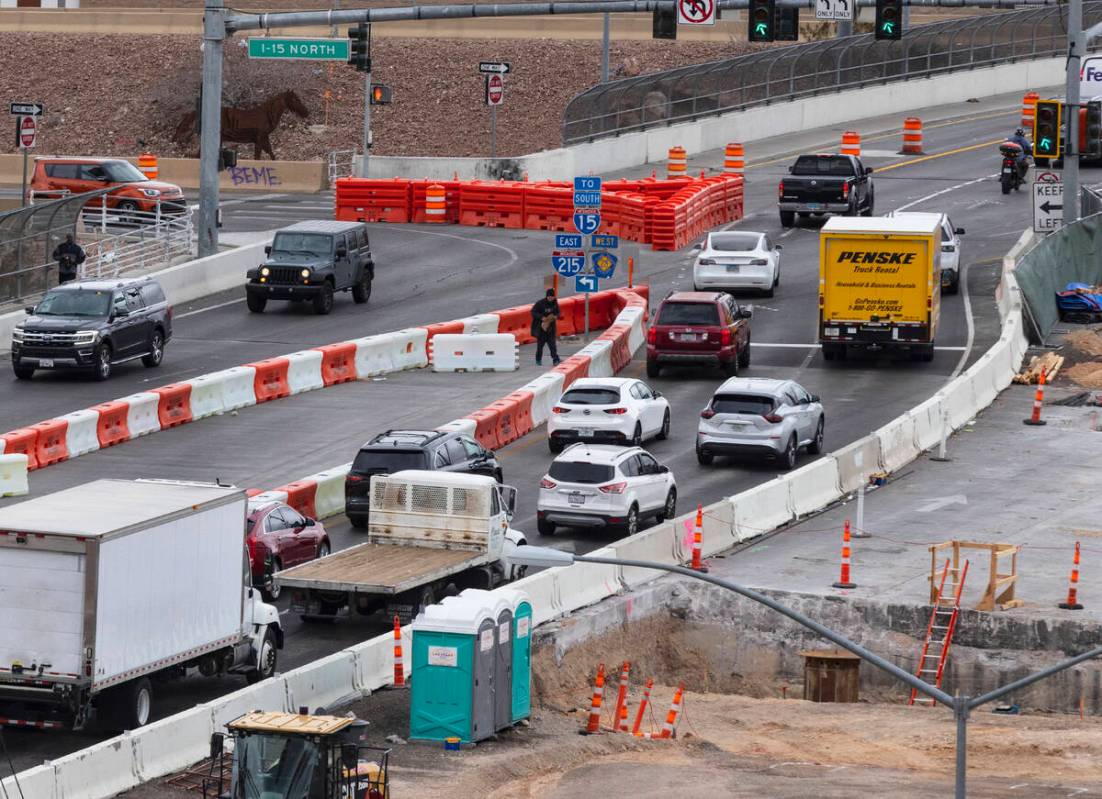A’s ballpark transportation plan relies on multiple road, busstop changes

If the Oakland Athletics land the public funding package being sought in the Legislature, traveling in the area of their proposed Las Vegas ballpark would be noticeably different come 2028.
A traffic study, commissioned by the A’s by engineering firm Kimley-Horn and obtained by the Review-Journal, lays out recommendations for how to increase travel in the area surrounding the Tropicana site, where the A’s would build a $1.5 billion, 30,000-seat ballpark.
If the A’s public funding bill, which is asking for $380 million between the state and Clark County, is approved, the team would plan to begin playing at the ballpark in five years.
The ongoing $305 million Interstate 15/Tropicana Avenue project is pointed to as a traffic benefit of the proposed stadium site.
The project, slated for completion in early 2025, will increase mobility on Tropicana over Interstate 15 and on Dean Martin Drive where it will no longer be a signalized intersection at Tropicana. It will also introduce a new access point to the resort corridor, via the Harmon Avenue HOV ramps.
The Boring Company’s planned Vegas Loop already has land-use approval for the Tropicana site. That would allow local fans to park at various resorts and for visitors at those properties to travel to and from the stadium via the underground transportation system.
Using other multimodal options also would be key to the traffic plan for the A’s ballpark. That includes ride-hailing companies such as Uber and Lyft, taxicabs, walking, and a game-day bus service similar to Golden Knights and Raiders games provided by the Regional Transportation Commission of Southern Nevada and the RTC’s general bus system.
“With the urban ballpark site plan balancing the fan access and departure distributions and dispersion to the surrounding pedestrian and street network, ballpark events at this site can be accommodated within the resort corridor,” Kimley-Horn’s ballpark transportation summary stated.
Recommended upgrades include:
■ Realigning the Reno Avenue-Giles Street curved intersection as a major four-way signalized intersection.
■ Widening Reno to create eastbound to northbound dual left turn lanes at Giles into the stadium site.
■ Widening Reno to create westbound to southbound dual left turn lanes at Giles.
■ Widening Reno at Las Vegas Boulevard to create westbound to southbound dual left turns and a westbound to northbound right turn lane.
■ Modifying the median along Las Vegas Boulevard to lengthen southbound to eastbound dual left turn lanes at Reno.
■ Adding a northbound right turn lane into a new stadium access road along Las Vegas Boulevard.
■ Widening the signalized Tropicana Avenue project access drive at Ocean Drive to provide northbound to westbound dual left turn lanes from site.
■ Potentially reconstructing and widening the pedestrian bridges across Las Vegas Boulevard and Tropicana to improve pedestrian ingress and egress to the southeast corner of the ballpark site.
■ Widening existing pedestrian crossing at the Tropicana/Ocean Drive signalized intersection to increase pedestrian access to/from MGM Grand.
■ Adding a double bus stop turnout along Tropicana Avenue at the stadium site.
■ Adding a double bus stop turnout along Las Vegas Boulevard at the stadium site.
With Reno noted multiple times in the proposed transportation improvements, it is evident that it is a key piece in the A’s transportation plan.
“The restructuring of Reno road, that is behind the Tropicana, is an important part of that traffic mitigation plan,” Steve Hill, Las Vegas Convention and Visitors Authority president and CEO, said during Wednesday’s Senate hearing.
Part of Clark County’s $145 million proposed public offering includes $25 million to go toward infrastructure improvements around the stadium site.
The traffic plan notes that stadium would be heavily supported by fans walking to and from the stadium from the various surrounding resorts.
MGM Resorts parking garages to play role
Using the thousands of spaces at parking garages at the surrounding MGM Resort properties would be a key part of the stadium plan, Hill said.
“There are 20,000 or so parking spots in structured parking on the four properties on that corner now,” Hill said of the Las Vegas Boulevard/Tropicana intersection. “Those will all be available to use and be able to disperse that traffic so it’s not actually centered all at the stadium site. An important part of reducing congestion.”
The parking plan appears to have the gaming company’s approval, as Jason Gray, vice president of government affairs for MGM Resorts, noted the industry giant was in support of the ballpark project.
“We welcome Major League Baseball and the A’s and believe their relocation to Las Vegas would cement our destination’s status as the premier sports and and entertainment destination in the world,” Gray said during Wednesday’s meeting. “We have seen this with T-Mobile Arena and Allegiant Stadium, home games drive accretive visitation and spending from spectators and fans.”
With the proximity of the A’s planned ballpark to T-Mobile Arena, Allegiant Stadium and Michelob Ultra Arena, the stadium would further enhance the sports district created on the south Strip. That district includes a shared parking plan and benefits the various restaurants and retail locations in the area.
“This means more guests staying in hotel rooms. This means more people dining in our restaurants and taking in the overall Las Vegas experience,” Gray said.
Contact Mick Akers at makers@reviewjournal.com or 702-387-2920. Follow @mickakers on Twitter. Send questions and comments to roadwarrior@reviewjournal.com.